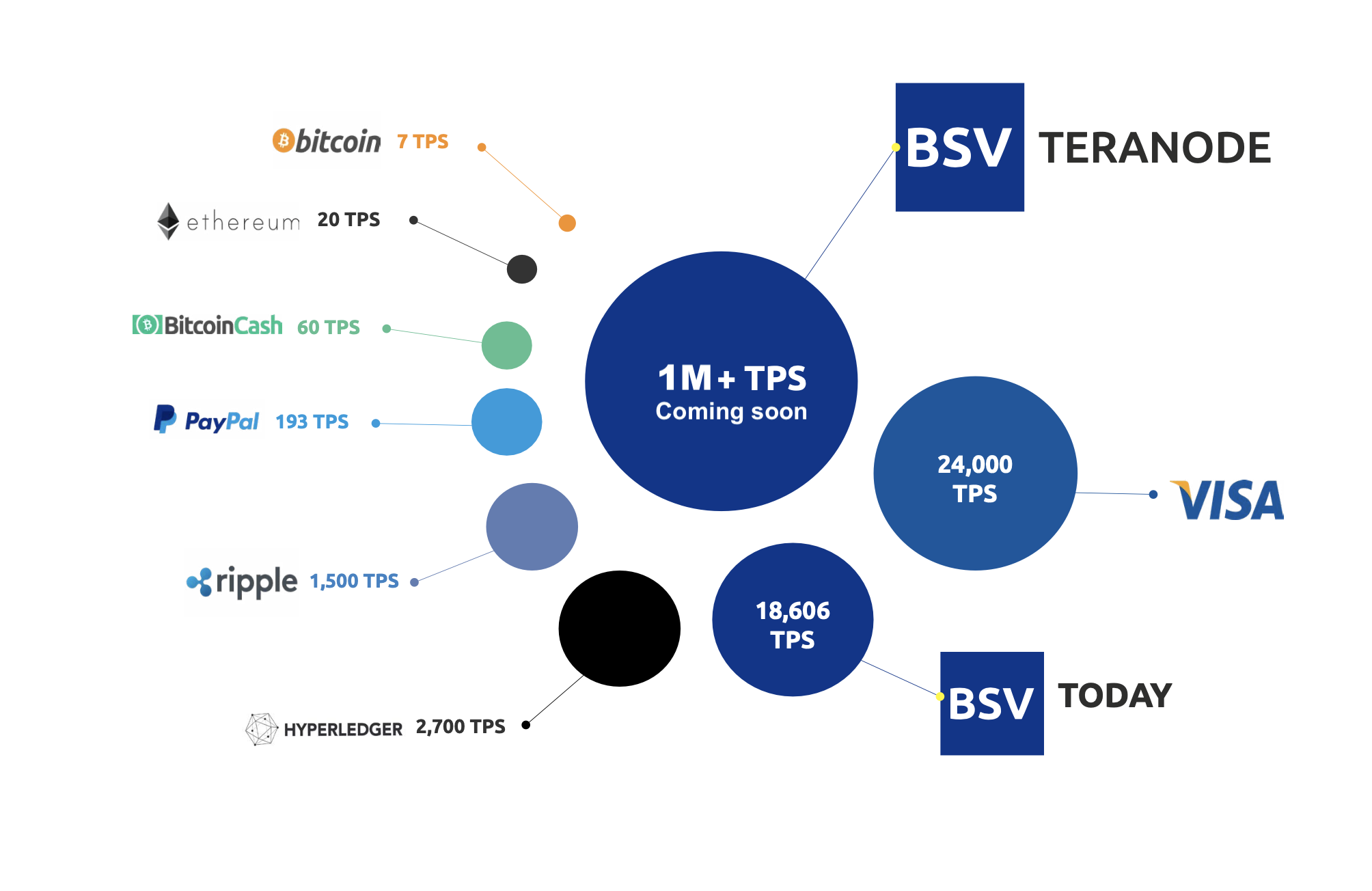Blockchain technology is well known for being a distributed network offering a highly secure and trustless peer-to-peer exchange of value with an immutable record.
While these features are inherent in most blockchain protocols, it’s less well known that there are blockchains with features that are equally valuable, especially to enterprises: privacy and accountability, security and scalability.
The BSV blockchain protocol’s inherent properties
This protocol that the BSV blockchain (or BSV) is based on comes with a large set of features and native capabilities which can be used by enterprise applications without building any complicated layer on top. Though the features are listed individually, the best way to understand these is together, as each feature complements the other and works together for the completeness of the protocol.
The salient properties of the BSV blockchain’s protocol that make it a transformative innovation are immutability, distribution, privacy and accountability, security, scalability and a trustless peer-to-peer exchange.
Blockchain’s well known features
Immutability
The BSV blockchain is an immutable ledger of transactions and data, with each block timestamped. In mathematical terms, blockchain records permanent evidence that an event ‘e’ occured in time ‘t’. BSV relies on two concepts to achieve immutability, one is a distributed timestamp server and other is proof-of-work.

As a distributed timestamp server, the BSV blockchain hashes the transactions of the block and associates it in the block header along with a unix time value of the formation of the block. This hash is unique to the block and since it is generated from the contents of the block, changing the contents would invalidate the hash stored in the block header at the time of block creation.
Generation of this hash requires miners to invest in CAPEX and spend on considerable OPEX in forms of recurring electricity bills. For a miner to prove that it mined the block, it needs to exhibit proof-of-work, which is easily verifiable by other miners in the network.
Proof-of-work is a form of cryptographic challenge or puzzle, which requires extremely high hashpower (computational resources) to solve and at the same time is very easy to verify once a solution is available. As the name suggests, it proves to the network that the miners have spent a significant amount of computational efforts validating a block of transactions.
Distributed system
For consumers and businesses, a node network is a distributed network. The protocol mandates for each node to agree and have an identical copy of the blockchain. Each node executes an identical set of immutable rules, i.e. programmed as part of node software. This provides resilience to the network as there can never be a single point of failure affecting end users.
It also adds trustlessness to the network, as end users do not have to trust a single node for validating integrity of transactions.
Lastly it makes the system economical for end users, specifically for businesses as they would be charged a fee for each transaction, which in turn can be negotiated as miners compete with each other to get more and more transactions. The nodes within themselves are hyper-connected and as the ecosystem grows and matures, the network topology between the nodes will emerge as a small world or mandala network. A visualisation of the overall network that forms is shown in Figure 1.2.

As shown in the image, the peer node network becomes the core of the BSV network. User nodes are lightweight nodes which come and go based on their need, accessing the BSV network using their connectivity with one or more miner nodes.
Trustless peer-to-peer (P2P) exchange
There are two important features of the protocol which enable P2P transactions between non-trusted parties. One is Simplified Payment Verification (SPV) and the other is the nSequence value for an input in a transaction. Both these features enhance scalability and cost-effectiveness for an enterprise using the BSV protocol.
Blockchain’s lesser-known features, available through BSV
Privacy and accountability
BSV handles privacy by separating identities of the two parties transacting from the transactions. For transferring monetary value, the sender needs to sign the ownership of the coins using a private key and in the same transaction, the receiver’s public key is associated with the transferred coins. This provides pseudonominity to the users while the ledger remains transparent and auditable. Additionally, the immutability of the ledger implies accountability.

As the transactions in the block cannot be erased or changed, it stores the digital karma of individuals and businesses forever, bringing all to accountability. Any illegal or criminal activities done using BSV can be easily traced via the immutable evidence trail and hence subject to action by the law enforcement system.
Security
Like many existing systems, security is both the responsibility of users and protocol. For individuals and business, there are recommended best practices to be followed which are not in the scope of this topic. From the protocol perspective, BSV implements the philosophy of economic security. There are multiple facets to this.
- The keys that provide access to ledger databases are not stored in the blockchain itself and are distributed across diverse systems, which makes it infeasible for any adversary to attack the system. This is unlike existing systems, in which sensitive information such as credit card details are stored in a centralised database which makes it easy to hack.
- Integrity of the transaction, specifically double spend, is the responsibility of the miners, and protocol mandates that not only the miner who mines the block validates it but also the majority of nodes perform the same validation before the block is accepted as valid.
- Finally, the aspect of economic incentives is tied to proof-of-work. It takes huge investment of hash power from nodes to mine blocks and keep running their businesses profitably. The protocol mandates nodes abide by the same set of immutable rules to form a consensus. If a node decides to waste hash power in attempting to get a invalid transaction accepted in the block, they limit their revenue generating ability as other nodes will not accept the block. If any node decides to overwrite the transaction in blockchain, protocol requires it to build a new proof-of-work chain and outpace the constantly lengthening chain-tip of their blocks to be considered as valid. This makes it computationally impractical to change or erase transactions captured in a block.
Scalability
With respect to scalability of the BSV blockchain network, enterprise product design needs to be cognisant about two facets – block size and individual transaction size.
Block size
In 2020, the BSV blockchain processed a 309 MB block containing over a million transactions, which was quickly followed by a 369MB block containing 1.3 million transactions. At the time of writing the biggest block mined was 3.8 GB in size and currently the network maintains an average block size of 100 MB. The main network has comfortably handled a peak throughput of 18,606 transactions per second (TPS) and the scaling test network has handled a peak load of 19,308 TPS.
By the end of 2022, a microservices-based node software framework called Teranode is planned to be released, which aims to deliver exponentially scaling capabilities – currently a minimum TPS of 50,000 to a maximum of 100,000 has already been demonstrated in testing environments using Teranode.
Terranode release employs horizontal scaling, which can enable further throughput scaling from these test results, making the BSV blockchain the most scalable blockchain that exists today.

One of the pivotal consequences of allowing big blocks is that it reduces the transaction fees for the miners and in turn enables microtransactions and nano-transactions.
Individual transaction size
The BSV blockchain also offers scalability on a transaction level, where it uses a native language called Script for supporting various contract types between entities exchanging value in the transaction. These scripts present in transactions contain not just payment information (digital signatures, value etc.) but also can contain data. There is no limit imposed in the protocol on the number of inputs or outputs, and each transaction can natively contain up to 4.2 GB of data using the OP_PUSHDATA opcode.
Of course, in reality this is restricted by miners who define local transaction processing rules, limiting the supported amount of data in input/outputs. Miners also support zero-value outputs, which can contain data written to the public ledger using the OP_RETURN method. This allows BSV transactions not just to work as payment but also data transactions that use the BSV ledger to become a real data ledger.
Enterprise blockchain products using BSV
To learn more about the properties of the BSV blockchain that make it unique among enterprise-scale blockchains and the applications and products that can be built using BSV blockchain, download our new eBook below.
eBook: Enterprise blockchain products using the BSV blockchain
To learn more about the properties of BSV’s underlying protocol, how the BSV blockchain’s implementation distinguishes it from other enterprise-scale blockchains and the applications and products that can be built using the BSV blockchain, download our new eBook.
